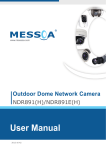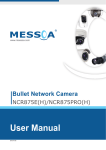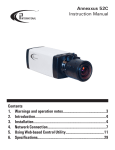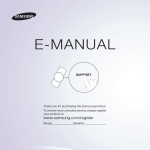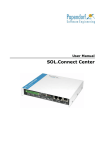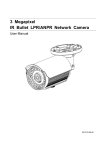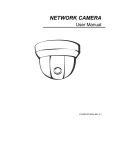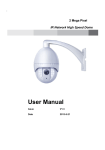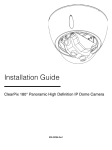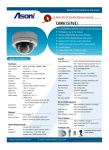Download User Manual
Transcript
Outdoor IR Dome Network Camera User Manual 2012-12 891PRO A1 Safety Notice The camera is intended for outdoor use. Make sure the supplied voltage meets the power consumption requirements of the camera before powering the camera on. Incorrect voltage may cause damage to the camera. The camera should be protected from water and moisture, excessive heat, direct sunlight and cold. The installation should be made by a qualified service personnel and should conform to all local codes. Unplug the camera during lightening storms or when unused for long period of time. Operating Notice This device should use power source as follows: • 12VDC/24 VAC or by PoE (IEEE 802.3af) for model without heater. • 24VDC/24 VAC for model with heater. Avoid viewing very bright objects (e.g. light fixtures) for extended periods. Avoid operating or storing the unit in conditions as follows: • Extremely humid, dusty, hot/cold environments where the operating temperature is outside the recommended range of -40°C to +50°C (for model with heater) or -10°C to +50°C (for model without heater). • Close to sources of powerful radio or TV transmitters. • Close to fluorescent lamps or objects reflecting light. • Under unstable light sources (may cause flickering). 2 User Manual CE Compliance Statement This equipment complies with the following requirements of the EMC Directive 2004/108/EC for CE Marking: EN 55022: 2006 + A1: 2007 Class B, EN 61000 and EN 50130. FCC Compliance Statement If the declaration of conformity markings are present on the equipment, the following statements apply: Tested to comply with FCC standards for HOME OR OFFICE USE. This device complies with Part 15 of the FCC Rules. Operation is subject to the following two conditions: (1) this device may not cause harmful interference, and (2) this device must accept any interference received, including interference that may cause undesired operation. This equipment has been tested and found to comply with the limits for a Class B digital device, pursuant to Part 15 of the FCC Rules. These limits are designed to provide reasonable protection against harmful interference in a residential installation. This equipment generates, uses, and can radiate radio frequency energy and, if not installed and used in accordance with the instructions, may cause harmful interference to radio communications. However, there is no guarantee that interference will not occur in a particular installation. If this equipment does cause harmful interference to radio or television reception, which can be determined by turning the equipment off and on, the user is encouraged to try to correct the interference by one or more of the following measures: • Reorient or relocate the receiving antenna. • Increase the separation between the equipment and the receiver. • Connect the equipment to an outlet on a circuit other than the one to which the receiver is connected. • Consult the dealer or an experienced radio/TV technician for help. WEEE Waste Electrical and Electronic Equipment Correct disposal of this product (applicable in the European Union and other European countries with separate collection systems). This product should be disposed of, at the end of its useful life, as per applicalbe local lows, regulations and procedures. The specifications or appearance of this product are subject to change without a prior notice. User Manual 3 Table of Contents Table of Contents 1. Overview................................................................................................. 6 1.1 Introduction..................................................................................................... 6 1.2 Package Contents............................................................................................. 6 1.3 Hardware Overview........................................................................................... 7 1.3.1 Dimensions.......................................................................................................... 7 1.3.2 Connector............................................................................................................ 7 1.3.3 Controls.............................................................................................................. 8 1.4 Specifications................................................................................................... 9 2. Camera Installation............................................................................... 10 2.1 Disassembling the Dome Camera...................................................................... 10 2.2 Drilling the Mounting Surface........................................................................... 10 2.3 Mounting the Camera...................................................................................... 11 2.4 Adjusting Camera Angle.................................................................................. 12 2.5 Assembling the Camera................................................................................... 13 3. Network Deployment............................................................................. 14 3.1 Network Connection Types............................................................................... 14 3.2 Accessing the Camera for the First Time............................................................. 16 3.3 Using “IP Finder” to Manage Cameras................................................................ 18 3.3.1 Installing IP Finder...............................................................................................18 3.3.2 Using IP Finder....................................................................................................18 4. Web-based Interface.............................................................................. 21 4.1 Overview....................................................................................................... 21 4.1.1 Main Screen........................................................................................................21 4.1.2 Setup Menu........................................................................................................22 4.1.3 Applying Settings.................................................................................................22 4.2 Image Settings.............................................................................................. 22 4.2.1 Codec ...............................................................................................................22 4.2.2 Exposure............................................................................................................25 4.2.3 White Balance.....................................................................................................29 4.2.4 Basic Settings.....................................................................................................30 4.2.5 Smart Encoding...................................................................................................31 4.2.6 Smart Focus........................................................................................................32 4.2.7 Privacy Zone.......................................................................................................33 4.2.8 ePTZ..................................................................................................................33 4 User Manual Table of Contents 4.3 Network........................................................................................................ 35 4.3.1 Basic..................................................................................................................35 4.3.2 FTP....................................................................................................................36 4.3.3 SMTP.................................................................................................................37 4.3.4 NTP...................................................................................................................37 4.3.5 RTSP..................................................................................................................38 4.3.6 ONVIF................................................................................................................39 4.4 System......................................................................................................... 40 4.4.1 Date and Time.....................................................................................................40 4.4.2 Time Stamp........................................................................................................41 4.4.3 Firmware............................................................................................................41 4.4.4 User Management................................................................................................43 4.4.5 Language . .........................................................................................................44 4.4.6 Log....................................................................................................................45 4.4.7 Audio.................................................................................................................46 4.5 Event............................................................................................................ 47 4.5.1 Motion Detection..................................................................................................47 4.5.2 External Alarms...................................................................................................48 4.5.3 Face Detection.....................................................................................................49 4.5.4 Blur Detection.....................................................................................................50 4.5.5 Audio Detection...................................................................................................51 4.5.6 Ethernet Detection...............................................................................................52 4.5.7 Event Management...............................................................................................52 4.5.8 Event Management...............................................................................................53 4.6 Recording...................................................................................................... 54 4.6.1 Settings – Video File.............................................................................................54 4.6.2 Settings – FTP.....................................................................................................54 4.6.3 Settings – SMTP..................................................................................................55 4.6.4 SD Card Storage Format Selection..........................................................................56 4.6.5 Period Setting.....................................................................................................57 5. VLC Player for RTSP Streaming Access................................................... 58 User Manual 5 1. Overview 1. Overview 1.1 Introduction The camera, a cost-effective solution, features Lumii™ technology that significantly increases light sensitivity to deliver crisp image in the dark. H.264/MPEG4/MJPEG triple streaming allows you to choose the appropriate compression format for your bandwidth. H.264 greatly reduces the size of video compared to MJPEG and MPEG4 without compromising image quality. Varifocal lens, 3-axis and PoE features facilitate simple installation. Also, it features intelligent motion detection and day/ night functionality for round-the-clock surveillance. In addition, a scratch-resistant dome bubble is equipped to protect the camera against external impacts and tampering. Other supported features include micro SD/SDHC card slot, alarm input/output, and two-way audio. 1.2 Package Contents The package includes these items: Outdoor IR Dome Network Camera x1 CD-ROM x1 Quick Start Guide x1 Guide Pattern Sticker x1 RJ-45 Female / Female Coupler x1 Accessories 6 • Tapping Type Flat Head Screw (#1) x3 • Plastic Anchor (#2) x3 • Machine Type Flat Head Screw (#3) x3 User Manual 1. Overview 1.3 Hardware Overview 1.3.1 Dimensions 121mm (4.76”) 141mm (5.55”) Ø108mm (4.25”) 1.3.2 Connector 1 2 3 4 5 6 7 1. Power In (Red+/Black-): Connect to DC 12V/AC 24V (for model without heater) or DC 24V/ AC 24V (for model with heater) power supply. If using the DC power supply, make sure the power connector is wired to correct polarities (Red+/Black–). If you are to use power via the PoE connection, this connector is not used. 2. RJ-45 Ethernet Connector: Network & PoE (Power over Ethernet) connection. Note that PoE is unable to drive the camera whose heater is operating. 3. BNC: Composite video output 4. Audio Out (Green): Audio output 5. Audio In (Red): Audio input 6. Alarm Out (Orange): Alarm signal output port Reserved (Green): Reserved contact User Manual 7 1. Overview RS-485 (Yellow): Contact for RS-485 7. GND: Ground (electricity) in electrical circuits Alarm In 1 (Red): Alarm signal input port Alarm In 2 (Brown): Alarm signal input port 1.3.3 Controls Focus [Near(N) & Far(∞)] Zoom [Tele (T) & Wide (W)] Near (N) & Far (∞): Use an appropriate tool to press the button for few seconds to reset the camera. Press and hold it within 5 seconds to reboot the camera. Hold longer than 5 seconds to load default settings. Zoom: Adjust the zoom control for desired image view. Focus: Adjust the focus for optimum picture sharpness. Reset: Use an appropriate tool to press the button for few seconds to reset or load default settings of the camera. Press and hold the button for within five seconds to reboot camera. Hold longer than 5 seconds to load default settings. 8 User Manual 1. Overview 1.4 Specifications Video Sensor Type 1/2.7” image sensor optimized for low-light performance Active Pixels 1920x1080 (HxV) Compression H.264, MPEG-4, MJPEG Streaming Triple simultaneous streams Resolution 1080p, SXVGA, 720P, XGA, SVGA, D1, VGA, 2CIF, CIF Max. Frame Rate 2MP 16:9 (1920x1080) at 30 fps (NTSC) and 25 fps (PAL) Day/Night Protocol IPv4, TCP/IP, UDP, HTTP, SMTP, DNS, DHCP, NTP, FTP, RTP, RTSP, RTCP, ICMP, UPnP Ethernet 10Base-T/100Base-TX PoE IEEE 802.3af, Class 3 ONVIF Yes Browser IE Browser 6.0 or above Security Two-level access with password protection I/O & Controls Power 2-pin terminal block Alarm In/Out Terminal block 2 in / 1 out Network 1 x RJ-45 Mechanical (ICR) D/N Control Audio In/Out 3.5mm phone jack 1-in / 1-out Day/Night Mode Auto Analog Video 1 x BNC, 1.0Vp-p, 75 ohm / 1 x RCA Shutter Time 1/10000s to 1/3.75s Selectable (60Hz); 1/10000s to 1/3.125s Selectable (50Hz) Reset System reboot/factory default Min. llumination IR LED Off (shutter speed: 1/15sec): 0.06 Lux @10IRE; 0.30Lux @50IRE IR LED On: 0 lux Video Output NTSC: 720 X 480@30fps; PAL: 720 X 576@25fps Bit Rate Control CBR/VBR (Primary Stream) Lens Type, Focal Length, F-number View Angle View Angle Adjustment IRIS Control Built-in Mechanical IR Cut Filter varifocal lens, f=3~9mm, F1.2 (Mega pixel lens) H: 93°(Wide)~31.7°(Tele)/ V:68.4°(Wide)~23.8°(Tele) Pan:0°-355°(Max.); Tilt:0°-90°(Max.); Rotate:0°-355°(Max.) DC IRIS IR LEDs Power Power Requirement W/O Heater: DC 12V & AC 24V ± 10% / PoE(IEEE 802.3af) W/ Heater: DC24V/AC24V± 10% Power Consumption W/O Heater: 8.5W W/ Heater: 28W (Heater ON), 8.5W (Heater OFF) Mechanical Dimensions (ØxH) Φ141 mm x 121 mm (Φ5.55” x 4.76”) Weight 1.3kg (2.87lb) 3-Axis Pan:0°-355°, Tilt:0°-70°, Rotate:0°-355° Protection IP67, IK10, vandal-proof Battery-backed Real-time Clock Yes; External RTC Environmental LED Quantity 20 pcs (850nm) IR Distance 25 meters (82 ft.) Operating Temperature W/O Heater: -10ºC ~ 50ºC (-14ºF ~ 122 ºF) W/ Heater: -40ºC ~ 50ºC (-40ºF ~ 122 ºF) IR Activation Under 10 Lux with auto-control Operating Humidity 10~ 90% RH LED Life More than 10,000 hours (50°) Storage Temperature -20ºC ~ 60ºC (-4ºF ~ 140 ºF) Audio Audio Communication Two-way mono audio, Full-duplex Compression G.711, PCM, 8kHz Audio In/Out External microphone and speaker Image Enhancement Image Settings AWB, AES, AGC Exposure Mode: Auto/Manual; White Balance: Auto/Manual; Backlight Compensation: 5x5 zones selectable; Sharpness, Saturation, Brightness, Contrast: 255-level sensitivity Digital WDR Yes; 5-level sensitivity Privacy Zone Yes; customized threshold privacy zone Image Orientation Mirror, Flip Frequency Control 50Hz, 60Hz Date & Time Stamp Yes Intelligent Video & Even Management Motion Detection 5x5 zones, 5-level sensitivity or customized threshold Face Detection 3 level sensitivity Audio Detection 5-level sensitivity or customized threshold Blur Detection Customized threshold Ethernet Detection Network loss detection Smart Encoding Configurable ROI for better picture quality Others Snapshot, Smart Focus, e-PTZ, Optimized i-frame setting Events Event Actions Storage Category Motion detection, face detection, audio detection, blur detection, Ethernet detection, external alarm File upload via FTP, SMTP and SD Card; Notification via email, HTTP and TCP External output activation; Video and audio recording to SD Card Alarm / Motion / Schedule / Un-interrupt recording Stores video clips and snapshots Local Storage Memory Card Slot microSD/SDHC Card up to 32 GB Memory Card Overwrite Yes Network User Manual 9 2. Camera Installation 2. Camera Installation 2.1 Disassembling the Dome Camera 1. Loosen the screw that securing the dome cover. 2. Rotate the dome cover counterclockwise to unlock and pull it free of the housing. 3. Then remove the inner liner by gently pulling it free of the two notches in the housing. Inner Liner Dome Cover Dome Cove Screw Caution Tip Note DO NOT expose the inner parts to air over 30 minutes during installation. Otherwise, the included desiccant may absorb too much moisture and thus cause vapor when the heater inside the dome camera operates. 2.2 Drilling the Mounting Surface 1. Post the “Guide Pattern” sticker on the mounting surface. 2. Aiming the circles (the figure below marked with “+“ ) on the sticker, drill four screw holes and one cable entry hole in the ceiling/wall. + + + + 10 User Manual 2. Camera Installation 2.3 Mounting the Camera 1. Insert the plastic anchors into the screw holes (this figure take the tapping type screws as the example to illustrate the mounting). 2. Use the tapping screws to secure the dome base to the surface. Pattern Sticker Plastic Anchor Dome Base Tapping Screw Caution Tip Note 1. While you are securing the camera with the accompanying screws, please be advised to hold the camera by its dome base. Do not hold the lens or lens base with force that may deform the lens. 2. Use the machine type screws if you are attaching the camera to a pendent mounting. Use the tapping type screws for all other surfaces. 3. For cement surfaces, insert the “Plastic Anchors” into the holes. For softer surfaces, do not use the “Plastic Anchors”. User Manual 11 2. Camera Installation 2.4 Adjusting Camera Angle Users can check the monitored view by wiring the RCA jack to a monitor. With an external monitor connected, you can adjust pan and tilt angles of the camera for appropriate or better view. Before making adjustments to the lens, please remove the inner liner first. RCA Jack for Composite Video Output Pan Adjustment: Rotate the lens base to adjust the horizontal angle. Tilt Adjustment: Tilt the lens base to adjust the vertical angle. Pan Angle (max. 355°) Tilt Angle (max. 70°) 12 User Manual 2. Camera Installation Horizontal rotation: Rotate the dome base to adjust the horizontal position. Do not turn the base more than 355° as this may cause the internal cables to twist and disconnect or break. Horizontal Rotation (max. 355°) Caution Tip Note When the tilt angle is less than 75 degrees, there is no distortion. Distortion Area 24° Wide Angle (9mm) 70° Tilt Angle 68° Tele Angle (3mm) 2.5 Assembling the Camera Follow the steps below when all the camera adjustments and cabling tasks are finished. 1. Assemble the inner liner. 2. Assemble the dome cover. 3. Secure the dome cover with the accompanying screws. User Manual 13 3. Network Deployment 3. Network Deployment 3.1 Network Connection Types There are many different ways that you can connect the camera to your network, depending on your applications requirements. You should always set the camera’s network settings according to your network configurations. The following diagrams depict some typical applications with guidelines on network settings. For more information on network settings, always consult with your network administrator or ISP as required. Type 1— Direct Connection to a PC Directly connect the camera to a PC using a standard Ethernet cable. To extend the connection length, you should use an RJ-45 female/female coupler to connect two Ethernet cables together. RJ-45 Coupler Caution Tip Note Although an RJ-45 coupler is used to extend the connection length, the total length between the PC and the IP camera must not exceed 100 meters (328 feet). The LAN port of the camera supports auto MDI/MDIX (Medium dependent interface crossover) so there is no need to use cross-over cable. To access the camera, the PC must be on the same network as the camera. The default IP address of the camera is a static one (192.168.1.30). Configure your PC’s IP address as 192.168.1. X (where X is a number between 2 to 254, excluding 30 and subnet mask as 255.255.255.0, and then your PC should be able to access the camera. Type 2: Connecting Camera(s) to a Local Area Network (LAN) To add the camera(s) to an existing LAN, just connect the camera(s) to the hub or switch on your network. If you want to provide the camera power via the Ethernet connection, a PoE compliant hub/ switch is required. Caution Tip Note The LAN port of the camera supports auto MDI/MDIX (Medium dependent interface crossover) so there is no need for an uplink port or the use of a cross-over cable. 14 User Manual 3. Network Deployment Assign an IP address to your camera following your network IP allocation policy. You can manually specify the IP address or allocate the IP address automatically using a DHCP server, if available on your network. Then, you can monitor and manage the camera via a web browser from a local PC. Router/Switch/Hub Type 3: Remote Connection via the Internet If the network where the camera resides is connected to the Internet, you can also provide remote access to your camera over the Internet. Typically a broadband router has a built-in DHCP function to assign a local IP address to your camera. You can alternatively assign a fixed IP address to the camera to prevent it from frequently changing. Router xDSL/Cable Modem To access the camera from a local PC, simply use the local IP address of the camera. To enable remote access, you must configure your router/firewall to forward an incoming request to that fixed local IP address of the camera. Therefore, when an external host sends a request to access your camera, the request will first reach the router’s external IP address and then be forwarded to the local IP address of the camera. Port forwarding is based on the service you want to provide. For example, forward HTTP port to enable remote web access to your camera, or RTSP port to enable access to video/audio streams from the camera. If your camera is configured to use a non-standard HTTP port, then you have to forward that port accordingly. User Manual 15 3. Network Deployment 3.2 Accessing the Camera for the First Time The camera comes with a web-based setup utility, allowing you to view the video of the camera and configure the camera for optimal use in your environment. To access the camera’s web-based control utility, you need a PC that meets the following requirements: Operating System: Windows Vista® or XP Browser: Internet Explorer Version 6.0 or later CPU: Intel® Pentium® 4 Processor 2GHz or higher RAM: 512 MB or more. Then take the following steps to connect your PC to the camera. Step 1: Make the connection For initial setup purposes, connect one end of an Ethernet cable to the RJ-45 connector of the camera and the other end to the LAN port on your PC. Step 2: Configure your PC’s IP address The camera uses a default IP address of 192.168.1.30 and subnet mask of 255.255.255.0. To have your PC on the same network with the camera, configure your PC’s IP settings as below: IP address: 192.168.1. X, where X is a number between 2 to 254, excluding 30. Subnet mask: 255.255.255.0. Ignore all other settings and click OK. Step 3: Link Verification between PC and Camera 1. Launch the Command Prompt by clicking the Start menu, Programs, Accessories and then Command Prompt. 2. At the prompt window, type ping x.x.x.x, where x.x.x.x is the IP address of the camera (the default is 192.168.1.30). If the message of “Reply from…” reponds, it means the connection is established. 16 User Manual 3. Network Deployment Step 4: Accessing the Camera from IE Browser Open the IE browser and enter the IP address of the camera in the URL field. The default is 192.168.1.30. When prompted for login, enter the user name and the password (The defaults: admin, 1234). Note that the user name and password are case-sensitive. User Manual 17 3. Network Deployment Upon successful login, you will see the live view screen shown below, which is an example for series introduction. 3.3 Using “IP Finder” to Manage Cameras IP Finder is a management tool included on the product CD. It is designed to manage your network cameras on the LAN. It can help find multiple network cameras, set IP addresses, show connection status and manage firmware upgrades. 3.3.1 Installing IP Finder Before proceeding, make sure your operating system is Windows Vista or Windows XP. To install the software, simple locate and double-click the IP Finder setup file on the provided CD. Then follow the on-screen prompts to proceed. 3.3.2 Using IP Finder To launch IP Finder, double-click the IP Finder shortcut on the desktop or click Start > Programs > IP Finder > IP Finder. After you launch IP Finder, it will search for all the available cameras on the same network. Click the plus sign next to “All Devices” to expand the menu and display all the found cameras. Clicking a target camera will show the live view (if available) and the detailed information of the camera, including the MAC address. Each camera comes with a unique MAC address, which is indicated on the product label. It helps identify which camera is currently accessed, particularly when multiple cameras are connected on your network. 18 User Manual 3. Network Deployment The Tool menu of the IP Finder allows you to perform these tasks: Search Network: This option allows you to search the cameras on the network. Set Master ID and Password: Allows you to set a master ID and password for managing the cameras with IP Finder. Management Tool: Allows you to restart the camera, update firmware, reset all of the camera settings to default (except network settings) and reset all of the camera parameters to default. For an individual camera, right-click the camera and a menu will provide these options: Go to Presentation URL: Launch IE browser to access the web-based utility of the camera. Set Device ID and Password: Set the login ID and password for managing the camera with IP Finder. User Manual 19 3. Network Deployment Network Information: Allows you to configure the camera’s network settings. 20 User Manual 4. Web-based Interface 4. Web-based Interface 4.1 Overview 4.1.1 Main Screen After you log in to the camera’s web-based control utility, you will first see the live view screen of the camera. The screen below is an example for series introduction. Live view video Snapshot button Camera name Setup button Alarm Indicator Recording Indicator The live view screen of the utility provides these options: Snapshot: Pressing this button takes a snapshot of the current live view screen. Live: Pressing this button displays the live view of the camera. Setup: Pressing this button allows you to access the setup page. Camera name: Displays the name of the camera. Recording Indicator: Turns red when the recording is proceeding. Alarm Indicator: Appears when an alarm is triggered. Live view video: Shows the live view of the camera. Note that the accessibility to the options varies according to the login account. Viewer: Allowed to view only the live view screen. Access to other options is restricted. Administrator: Can access all the options on the live view page and make configurations on the setup pages. User Manual 21 4. Web-based Interface 4.1.2 Setup Menu The Setup options are categorized into five groups: Image, Network, System, Event and Recording. Clicking the name will expand its sub-menu. See the ensuing sections for more information. 4.1.3 Applying Settings Each configuration page provides a Save button. Settings are applied right after you press the Save button. And the browser will refresh to load the latest setting or otherwise pop up the “Save OK” message to indicate that settings have been applied. 4.2 Image Settings 4.2.1 Codec The Codec page allows you to configure the video streams for the camera. You can optionally configure a secondary or third stream to a resolution as required by your third-party device or software. * The figure above is an example for web interface introduction purposes. Options within each item may differ slightly among series products. 22 User Manual 4. Web-based Interface Camera Name Settings Enter a descriptive name of the camera. Note that if you want to make the camera ONVIF compliant (see Network > ONVIF ), no space is allowed in the camera name. H.264 Codec Settings Resolution: Click the drop-down menu to choose a resolution for the video. Bit Rate: According to your bandwidth, specify a value for data transmission rate (kbps). Higher value gets higher video quality but consumes more bandwidth. Frame Rate: Choose the intended frame rate, i.e., the number of frames to transmit per second. I-fram Interval: While keeping the same frame rate, you can specify longer I-frame interval to achive reduced bit rate, optimized bandwidth consumption and minimized storage space consumption. Generally, it’s recommended setting longer interval for less motion and sufficient lighting conditions, and shorter interval for scenes with lots of motion and low lighting conditions. Click the drop-down menu to select options including 1/2, 1, 2, 3, 4 seconds. MPEG4 Codec Settings Resolution: Click the drop-down menu to choose a resolution for the video. Bit Rate: According to your bandwidth, specify a value for data transmission rate (kbps). Higher value gets higher video quality but consumes more bandwidth. Frame Rate: Choose the intended frame rate, i.e., the number of frames to transmit per second. I-fram Interval: While keeping the same frame rate, you can specify longer I-frame interval to achive reduced bit rate, optimized bandwidth consumption and minimized storage space consumption. Generally, it’s recommended setting longer interval for less motion and sufficient lighting conditions, and shorter interval for scenes with lots of motion and low lighting conditions. Click the drop-down menu to select options including 1/2, 1, 2, 3, 4 seconds. MJPEG Codec Settings Resolution: Click the drop-down menu to choose a resolution for the video. Quality: Set the image’s quality as High, Normal or Low. Frame Rate: Choose the intended frame rate, i.e., the number of frames to transmit per second. Caution Tip Note 1. Live View uses the MJPEG codec. If no streaming is using MJPEG, it will result in no video for Live View. 2. If MJPEG is selected for both the primary stream and the third stream, Live View will always display video using the third stream codec settings. User Manual 23 4. Web-based Interface Refer to the tables below for selectable codec types for each streaming: Streaming Combination Primary Codec Secondary Resolution Codec Resolution OFF N/A Third Codec Resolution OFF N/A OFF N/A D1 1080P H264 VGA MPEG4 2CIF CIF MJPEG SXVGA OFF N/A 720P XGA D1 SVGA H264 VGA D1 MPEG4 2CIF MJPEG OFF MJPEG CIF OFF 1080P OFF N/A MJPEG OFF MPEG4 SXVGA OFF N/A 720P XGA D1 SVGA H264 VGA D1 MPEG4 2CIF MJPEG OFF MJPEG CIF OFF OFF 1080P N/A D1 H264 VGA MPEG4 2CIF H264 720P MJPEG OFF OFF N/A XGA SVGA D1 User Manual OFF CIF SXVGA 24 MJPEG H264 MPEG4 D1 VGA 2CIF MJPEG VGA CIF N/A VGA CIF N/A VGA CIF N/A VGA CIF N/A VGA CIF N/A VGA CIF N/A VGA CIF N/A VGA CIF OFF N/A MJPEG VGA 4. Web-based Interface Mirror Settings This option allows you to mirror or flip the video image if required. OFF: Turns off this function. HORIZONTAL: Flips the images horizontally. VERTICAL: Flips the images vertically. BOTH: Flips the images vertically and horizontally. Rate Control Choose a bit rate control to manage your bandwidth usage. Variable Bit Rate (VBR): VBR keeps the video stream quality as constant as possible by varying bit rate. This mode ensures high quality image for motion scene and is often selected when image quality demands priority. However, this mode requires more bandwidth in order to vary the bit rate. Constant Bit Rate (CBR): CBR maintains a specific and constant bit rate by varying the stream quality. With CBR, streaming is smooth and network throughput is stable for any scene. This mode is typically used with a limited bandwidth environment. TV Output Stream Turn on this option if you connect the camera’s BNC connector to an analog monitor for video output. When finished, click Save to have the configuration take effect. 4.2.2 Exposure The Exposure page allows you to configure the exposure settings, the exposure settings under auto iris mode, and the backlight compensation settings to meet the image quality requirements in relation to lighting and other considerations. Exposure Mode Choose among Auto Exposure, Manual Exposure, or Auto IRIS Mode to configure the exposure settings. When one is selected, the other two will not be configurable. User Manual 25 4. Web-based Interface Auto Exposure Settings Method: Select which area of the image will be used to measure the amount of light to achieve best exposure. • Center Weighted: Exposure metering is averaged over the entire frame but emphasis is placed on the central area. • Object Targeted: This option meters the exposure based on the targets you specify. When this option is selected, define your target by clicking squares displayed on the image and then press Save Spot Window to save the setting. EV: In a scene with predominantly light or dark areas, the image will be underexposed or overexposed, causing an image to be too dark or bright. In such situations, you can adjust a compensation value to optimize the exposure. Decrease the value if images appear too light (overexposed). Increase the value if images are too dark (underexposed). Max/Min. Exp: Select the maximum / minimum exposure time according to the light source. The selectable value will change according to the frequency setting under Image > Basic Settings. Sensitivity: Select how sensitive the camera reacts to the light. A higher value enables the camera to be more sensitive to the light conditions and adjust the exposure in the shortest time interval. Max Gain: Specify the maximum amount of amplification applied to the image. A high level of gain allows images to be viewable in very low light, but will increase the image noise. Manual Exposure Settings Exposure Time: Enter a desired exposure time. Gain: Select a gain value from 0 to 16. A high level of gain allows images to be viewable in very low light, but will increase image noise. Auto IRIS Mode Select Auto IRIS Mode to configure the exposure settings with the auto iris control enabled. 26 User Manual 4. Web-based Interface Method: Select which area of the image will be used to measure the amount of light to achieve best exposure. • Center Weighted: Exposure metering is averaged over the entire frame but the emphasis is placed on the central area. • Object Targeted: Define your target by clicking squares displayed on the image and then press Save Spot Window to save the setting. EV: Decrease the value if images appear too light (overexposed). Increase the value if images are too dark (underexposed). Convergence Speed: Select the lens’ convergence speed from the drop-down list. Higher the convergence speed, the faster the lens iris opening responds to changes in light levels. Shutter Settings: Slow Shutter: Set the exposure time from a set of fixed shutter speeds. Manual Exposure Time: Manually input a desired exposure time. Gain Settings: Max. Gain: Specify the maximum amount of amplification applied to the image. A high level of gain allows images to be viewable in very low light, but will increase the image noise. Manual Gain: Select a gain value from 0 to 16. User Manual 27 4. Web-based Interface BLC (Backlight Compensation) The Backlight Compensation function allows you to provide the optimal exposure of subjects under back light circumstances. OFF/ON: Choose to enable or disable the BLC function. BLC area setting: BLC area refers to the dark area where more details are expected. Define your BLC area by clicking squares displayed on the screen and then click Save BLC Window to save the setting. Digital Wide Dynamic Range When there are both very bright and very dark areas simultaneously in the field of view, you can enable Digital Wide Dynamic Range (WDR) function. It optimizes an image to ensure that dark areas are more visible while retaining details in bright areas. 28 User Manual 4. Web-based Interface Level: Depending on the contrast/dynamic range of a scene, you can select different level of WDR. Higher level of WDR suits for higher contrast/dynamic scene. If you select Auto mode, the camera will automatically adjust the WDR level by itself depending on the scene. 4.2.3 White Balance Select a white balance mode according to external light condition for the best color temperature. Auto White Balance: Use this option when there is no special lighting in the environment. The camera will automatically adjust the color temperature according to the light conditions and the sensitivity you specify. The higher the sensitivity, the faster the adjustment. If the lighting conditions change frequently, select a lower sensitivity to prevent the camera from frequently changing white balance. Manual White Balance: With any special light in the environment, you can use this option to manually adjust the red, green and blue channels, which are mostly affected by the special light. For example, if red color is too bright, then you should lower the R Gain value. When finished, click Save to have the configuration take effect. User Manual 29 4. Web-based Interface 4.2.4 Basic Settings The Basic Setting allows you to specify a frequency and adjust the basic image settings to optimize your video image. Frequency: Select an appropriate frequency to reduce the flicker on the image. “50 Hz” and “60 Hz” are provided. Frequencies settings will affect the Max. Exposure and Min. Exposure settings under Image > Exposure. TV System: Displays the current video standard: NTSC or PAL. This setting cannot be changed via web interface. Brightness: Adjust the image brightness level. Contrast: Adjust the image contrast level. Saturation: Adjust the image saturation level. Sharpness: Adjust the image sharpness level. Default All Image Parameters: Click this button to restore all the image settings to the defaults. When finished, click Save to have the configuration take effect. 30 User Manual 4. Web-based Interface 4.2.5 Smart Encoding On the Smart Encoding page you can specify a specific region of the video as more important, i.e., a region of interest (ROI). When a ROI is specified, the camera will assign a higher number of bits to the ROI area to deliver better video quality than non-ROI areas. Caution Tip Note The Smart Encoding function is only available when H.264 is selected for one of the streams. Basic Setting To define a smart encoding area, click and drag your mouse on the image to define the region of interest and click Save Window to save the region. Click anywhere on the image to cancel the current defined area. Mode: Select Fixed ROI to enable smart encoding function. Priority: Select a priority level for the ROI. User Manual 31 4. Web-based Interface 4.2.6 Smart Focus In addition to observing the live view image to see if focus is achieved, you can also enable Smart Focus to help you verify if focus is locked. If this function is enabled, whenever focus is achieved, the focus window turns green. Basic Settings To focus on a desired subject using the Smart Focus function: 1. Click on the subject that you want to focus on and then click Save Window. 2. Check the Smart Focus Enabled box. This will turn the smart focus indicator to red. 3. Use the focal length and focus controls to optimize the focus. When focus is achieved, the indicator turns green. 32 User Manual 4. Web-based Interface 4.2.7 Privacy Zone Privacy Zone allows you to mask sensitive areas of the image for privacy protection. If enabled, it will mask the live view and the recorded video clips/JPEG files. To turn on the privacy zone function: 1. Click and drag your mouse on the image to define the region to be masked and then click Save Window. 2. Select ON to enable Privacy Zone. This will turn the masked area to black. 4.2.8 ePTZ With the ePTZ function, you can use the pan, tilt and zoom controls to steer the camera to a desired position and focus on desired close-up areas, without moving the camera physically. Before using the ePTZ function, make sure the TV Out Stream is set to OFF. Please refer to the Image > Codec page. On the main screen, a PTZ button appears. After you click the PTZ button, an ePTZ control panel will shows up where you can click the corresponding indicators to perform desired operations: • To zoom in/out: Click the +/- indicator repeatedly to zoom in/out the live view image. • To pan left/right: Click the left/right indicator to pan the viewing area. The pan function does not work if the video is not zoomed-in (no zoom status). • To tilt up/down: Click the up/down indicator to tilt the viewing area. The tilt function does not work if the video is not zoomed-in (no zoom status). • To preset to home: Click the home indicator and the image will return to the original view. User Manual 33 4. Web-based Interface 34 User Manual 4. Web-based Interface 4.3 Network 4.3.1 Basic DHCP: If there is a DHCP server on the network and you enable this option, the server will automatically assign an IP address and related information to the camera. Caution Tip Note If there is no DHCP server on your network or you prefer to manually assign an IP address to the camera, leave the DHCP checkbox blank. IP Address & Subnet Mask: If the DHCP function is not enabled, you have to assign an IP address with the subnet mask to the camera. Default Gateway: Enter the IP address of the gateway if required. Please contact your network administrator whether you need to set up the gateway. DNS: Enter the IP address of a DNS server. If you enter a domain name instead of an IP address in server-related fields, e.g., FTP, SMTP or NTP server, then the camera will need a DNS server to translate domain names into an IP address that is actually used for communication on the Internet. HTTP Port: Use the standard HTTP port number 80 or alternatively specify another port number between 1025 and 65535. If you choose to use a non-standard port, and the camera on the LAN is to be accessible from the Internet, then you must configure your router/firewall to forward incoming HTTP request to that specified port (via NAPT/port forwarding settings). MAC: Display the MAC address of the camera. Each camera comes with a unique MAC address, which is indicated on the product label. It helps you to identify which camera is currently accessed, particularly when multiple cameras are connected to your network. When finished, click Save to have the configuration take effect. User Manual 35 4. Web-based Interface 4.3.2 FTP To allow the camera to upload recorded video clips/JPEG files to an FTP server, you have to specify an FTP server and configure related settings. FTP Server IP: Enter the IP address of the FTP server. FTP Server Port: Enter the port number of the FTP server. User Name: Enter the user name to logon to the FTP server. Password: Enter the password to logon to the FTP server. File Upload Path: Specify the folder which has been created under FTP server root directory. When finished, click Save to have the configuration take effect. 36 User Manual 4. Web-based Interface 4.3.3 SMTP To enable the camera to send you email notifications when an alarm is triggered, you need to specify an SMTP server to send the emails. My Server Requires Authorization: If your SMTP server requires authorization to send emails, enable this option. SMTP Server IP: Enter the IP address of the SMTP server. User Name: Enter the user name to log on to the SMTP server. Password: Enter the password to log on to the SMTP server. Sender: Enter the email address to be shown as the sender of the notification email. Receiver: Enter the email address to which the notification email is sent. When finished, click Save to have the configuration take effect. 4.3.4 NTP If you want the camera to synchronize its time clock with an NTP (Network Time Protocol) sever, configure the NTP server settings here. NTP Server: Enter the IP address or the domain name of the NTP server to synchronize with. Time Zone: Select a time zone in which the camera is located. User Manual 37 4. Web-based Interface DST: Tick the Automatically Adjust for Daylight Saving Time Changes check box to apply the daylight saving time and users are supposed to configure the start/end time period by clicking the drop-down menus respectively. When finished, click Save to have the configuration take effect. 4.3.5 RTSP RTSP is a standard for establishing and controlling sessions for streaming data over the web. If you want to allow third-party devices or software to access video/audio streams from the IP camera over the network, you must configure the RTSP ports. You can provide up to 6 streams according to the specific codec mode with different RTSP port. And when finished, click Save to have the configuration take effect. To use an RTSP player to access the camera’s streams, you have to use correct RTSP URL to request the streams. Refer to the table below for RTSP URLs: Stream URL MJPEG Primary rtsp://192.168.1.30:8555/mjpeg MJPEG Third rtsp://192.168.1.30:8558/mjpeg H.264 Primary rtsp://192.168.1.30:8557/h264 H.264 Secondary rtsp://192.168.1.30:8556/h264 MPEG4 Primary rtsp://192.168.1.30:554/mpeg4 MPEG4 Secondary rtsp://192.168.1.30:8554/mpeg4 *Replace the IP address and the port number with the camera’s settings if otherwise configured. 38 User Manual 4. Web-based Interface 4.3.6 ONVIF ONVIF is a standard that ensures interoperability between IP-based physical security products regardless of the manufacturers. This camera is ONVIF compliant and you can configure whether the camera can be found by other ONVIF compliant products and the related settings. Basic Settings Discovery via ONVIF: Check the box if you want the camera to be found by other ONVIF compliant devices in a network, e.g., an ONVIF compliant NVR. Accept command/functionality outside of Discovery capability: If checked, the camera is allowed to accept commands from ONVIF compliant device thus changing the camera’s functionality. User Authentication: If an ONVIF compliant device needs authentication for communication, enable this option. When finished, click Save to have the configuration take effect. User Manual 39 4. Web-based Interface 4.4 System 4.4.1 Date and Time Current Time Displays the current date and time of the camera. Date and time will be updated after you configure new settings in the New Time section and click Save to apply the settings. New Time You can set the camera time by one of the following methods: Set Manually: Manually enter the camera’s date and time settings in the given fields. Synchronize with Computer Timer: Use this option to synchronize the camera’s date and time with the computer timer. Synchronize with NTP Server: Use this option to synchronize the camera’s date and time with an NTP (Network Time Protocol) server, which can be configured under Network > NTP. Date Format: Allows you to specify a desired date format. When finished, click Save to have the configuration take effect. 40 User Manual 4. Web-based Interface 4.4.2 Time Stamp The Time Stamp function allows you to overlay the date and time stamp on the video. When enabled, the recorded video will be displayed with the date and the time. Enable Date and Time Stamp: Check this box to enable the date and time stamp on images/ video clips; to disable this function, uncheck the box. Date Format: Select the desired date format for the time stamp. When finished, click Save to have the configuration take effect. 4.4.3 Firmware Current Version Description: Displays the current version of the firmware. Specify the Firmware to Update: This function is designed to update the firmware of the camera. To perform the firmware upgrade, follow these parameters: Keep the network connected during the update process. DO NOT turn off or restart the camera during the firmware update process. To update the firmware: 1. Click the Browse button to locate the firmware file. User Manual 41 4. Web-based Interface 2. Click the Update button to start update. 3. When prompted, click OK to proceed. 4. Wait about 20~60 seconds until the file is successfully updated. Once the update is completed, the browser will show a message reads “Firmware update successful”. Then it will take 60 seconds to restart the camera. 5. The utility will automatically go back to live view screen after firmware has been updated successfully. You can also perform these tasks on the Firmware page: Restart Camera: Restart the camera. This will cause all streams to disconnect. Factory Default: Reset all of the camera settings to the defaults, except network settings. After you confirm to reset, the parameters will be reset and the camera restarts automatically. When completed, you will return to the live view page. Hardware Factory Default: Reset all of the camera parameters to the defaults, including the network settings. 42 User Manual 4. Web-based Interface 4.4.4 User Management The User Management page allows you to manage user accounts and access privileges. User List Displays the list of current user accounts of the camera. To delete a user account, select the unwanted user account from the list and then click Delete User. Add/Modify User You can add a new user or modify current users’ account or authority. To add a new user, enter the user name and password and specify the authority. Then click Add/ Modify User to add a user. To modify the password of an existing user, enter the user name and modify the password. Then click the Add/Modify User button. Two types of account can be specified: • Admin (Administrator): Can access all camera functions, pages and change configurations. • Viewer (Guest): Can only access the live view page and take snapshots. User Manual 43 4. Web-based Interface 4.4.5 Language The Language drop-down menu allows you to change the language of the web interface. Supported languages include English, Spanish, Italian, Simplified Chinese and Traditional Chinese. Click Save to apply the language setting, and the browser will automatically refresh to reflect the change. 44 User Manual 4. Web-based Interface 4.4.6 Log This page displays detailed information about the camera’s operations and activities, including all the login and alarm records. Clear Log File: Click the button to clear the log cache. Download Log File: Click the button to save the current log into a text file. When a dialog window shows up, click the Save button to locate the directory where the logfile.txt is to be stored. User Manual 45 4. Web-based Interface 4.4.7 Audio Audio Receiving: If a microphone is connected to the camera, you can select ON to allow the camera to record the audio and transmit to your PC. This enables the camera to pick up sounds in the background. Audio Receiving Volume: Allows you to adjust the audio recording volume of the camera ranging from 1 to 4. Audio Playing: If a speaker is connected to the camera, you can select ON to allow the camera to play the audio transmitted from your PC. This enables you to speak to the person(s) around the camera. Audio Playing Volume: Allows you to adjust the audio playing volume of the camera ranging from 1 to 4. Using the two-way audio function Note that the two-way audio function is only active in the live view page using the web browser. To use the two-way audio function: 1. Make sure a speaker is connected to the Audio Out port and a microphone is connected to the Audio In port of the camera. 2. Enter System > Audio and enable both the Audio Receiving and Audio Playing functions. Then adjust the audio volume to the desired level. To access the two-way audio streams: 1. Make sure your computer is connected to a microphone and speaker. Enter the live view page of the web-based utility. 2. Speak into the microphone and the person(s) around the camera should hear your voice. 3. When people around the camera are talking to you, you should hear them from the speaker that is connected to the computer. 46 User Manual 4. Web-based Interface 4.5 Event When an event occurs, it triggers an alarm and the camera will take a pre-defined action, e.g. sending a recorded video clip or JPEG files to a designated server. With this camera, an event can be triggered by the camera’s detection mechanism. 4.5.1 Motion Detection When the Motion Detection is enabled, the camera detects motion under a pre-specified condition within a designated area. When motion is detected, the camera will generate an alarm and then take a specified action. Caution Tip Note Keep the conditions below in mind when you use the motion detection function. Please refer to the Codec section. You must select MJPEG codec for one of the streams to enable the live view. You must select H.264 or MPEG4 codec for one of the streams to process the motion detection. Configuration Motion Sensitivity: Specify the sensitivity to moving objects before the camera triggers an alarm. The higher the sensitivity, the slighter the movement is required to set off an alarm. You can alternatively select User Define and enter a value from 1 to 100 in the Customized Threshold field. When the motion within a specified area exceeds the threshold, an alarm will be triggered. Select the OFF radio button to disable motion detection User Manual 47 4. Web-based Interface Motion Area Setting Motion area setting: Click target squares displayed on the screen to define detection areas; once configured, click Save Motion Area to save the settings. Action Specify the action to be taken when an alarm is triggered upon motion detection: OFF: No action will be taken, but an alarm will be logged. FTP: Recorded video clips/JPEG files will be uploaded to the FTP server when alarm is triggered. SMTP: Notification email with the recorded JPEG files attached will be sent to the SMTP server. SD Card: Recorded video clips will be saved to the SD card when the alarm is triggered. 4.5.2 External Alarms If external alarm devices, e.g., sensors and alarms, are connected to the camera’s alarm input/ output, the following settings must be made: Configuration Setting: Enable the Alarm I/O that is connected with the respective external alarm device. Level: Set the (electricity) current as low or high to define the active state. Action Specify the action to be taken when external alarm is triggered: OFF: No action will be taken, but an alarm will be logged. FTP: Recorded video clips/JPEG files will be uploaded to the FTP server when alarm is triggered. SMTP: Notification email with the recorded JPEG files attached will be sent to the SMTP server. SD Card: Recorded video clips will be saved to the SD card when the alarm is triggered. Caution Tip Note 48 User Manual 4. Web-based Interface To perform a video recording, you must select MJPEG codec for one of the streams. 4.5.3 Face Detection With the Face Detection enabled, one or multiple square frames will cover the faces detected in the scene. You can specify a particular area by clicking and dragging your mouse, and then click the Save Window button. People’s faces appearing within the area will be detected. Click the Delete Window button followed by clicking Save to remove the defined region. Basic Settings Face Detection: Enable/Disable face detection. When the selected radio button is changed and the Save button is clicked, the camera may take around 25 seconds to restart while the web displaying the status being loading. Detection Box: Select ON to show square frames on the screen for the detected faces. Direction: Select the orientation of faces in the video stream. UP means the top of the face is generally in the up direction. The orientation may need to be adjusted when the camera is installed on its side or at an angle. Threshold: Select a face detection acceptance tolerance ranging from 0 to 9. Minsize: Select the minimum size of the detection box. Options include 20, 25, 32 and 40; smaller value means smaller faces in the distance can be detected. Priority: Select whether face regions have higher or lower encoding priority when the Advanced Settings ROI feature is applied. User Manual 49 4. Web-based Interface Action Select the radio buttons for actions in response to the pictures saved to FTP server, SMTP server or SD card if a face detection alarm is triggered. OFF is set by default. OFF: No action will be taken (but an alarm is logged). FTP: Recorded AVI/JPEG files will be uploaded to an FTP server when the alarm is triggered. SMTP: Notification e-mail attached with the recorded JPEG files will be sent to a SMTP server. SD Card: Recorded AVI/JPEG files will be saved to the SD card when the alarm is triggered. 4.5.4 Blur Detection With the Blur Detection enabled, when the camera detects incidents that make video image blur, e.g. redirection, blocking or defocusing, the camera will generate an alarm and then take a specified action. Caution Tip Note Note that to use the blur detection function, the following two conditions must be met: You must select MJPEG codec for one of the streams to enable the live view. You must select H.264 or MPEG4 codec for one of the streams to process the motion detection. Configuration Blur Detection: Select Enable to enable Blur Detection; select Disable to disable this function. Sensitivity: You can alternatively customize the camera’s sensitivity to a blur. The camera will judge whether it has been tampered based on the sensitivity threshold specified. Action OFF: No action will be taken, but an alarm will be logged. FTP: Recorded video clips/JPEG files will be uploaded to the FTP server when alarm is triggered. SMTP: Notification email with the recorded JPEG files attached will be sent to the SMTP server. SD Card: Recorded video clips will be saved to the SD card when the alarm is triggered. 50 User Manual 4. Web-based Interface 4.5.5 Audio Detection With the Audio Detection enabled, when the camera detects any sound, the camera will generate an alarm and then take a specified action. Configuration Audio Sensitivity: Specify the camera’s sensitivity level to the audio signal. The higher the sensitivity, the lower the volume is required to set off an alarm. When set to OFF, the audio detection is disabled. Action Specify the action to be taken when an alarm is triggered upon audio detection: OFF: No action will be taken, but an alarm will be logged. FTP: Recorded video clip will be uploaded to the FTP server when the alarm is triggered. SMTP: A notification email attached with the recorded video clip will be sent to the SMTP server. SD Card: Recorded video clip will be saved to the SD card when the alarm is triggered. Caution Tip Note To perform a video recording, you must select MJPEG codec for one of the streams. User Manual 51 4. Web-based Interface 4.5.6 Ethernet Detection With Ethernet detection enabled, when the camera detects an Ethernet disconnection, the camera will generate an alarm and then take a specified action. Configuration Trigger an Alarm When Ethernet is Disconnected: Select whether to disable/enable this function. Action Specify the action to be taken when an alarm is triggered upon audio detection: OFF: No action will be taken, but an alarm will be logged. SD Card: Recorded video clips will be saved to the SD card in AVI format when the alarm is triggered. Caution Tip Note Regardless of your settings in Recording > SD card, when an Ethernet disconnection is triggered, the video clip recording will always be saved in AVI format. 4.5.7 Event Management Basic Setting Alarm Duration: Specify the duration of the alarm when an event is triggered. 52 User Manual 4. Web-based Interface Alarm Reset: Click this button to stop the current alarm and to restart event detection again. When finished, click Save to have the configuration take effect. 4.5.8 Event Management Basic Setting Alarm Duration: Specify the duration of the alarm when an event is triggered. Alarm Reset: Use this button to stop the current alarm and to restart event detection again. User Manual 53 4. Web-based Interface 4.6 Recording Recording allows you to configure recording-related settings and schedule recording. The defaults are listed in the table below: 4.6.1 Settings – Video File Configure the duration and format of video to be recorded when an alarm is triggered. Basic Settings AVI Duration for FTP Server: Select recorded video duration in seconds for the FTP server. AVI Duration for SD Card: Select recorded video duration in seconds for the SD card. AVI Format: Select a desired video format. Available formats depend on the primary and the secondary streaming codec/resolution settings. 4.6.2 Settings – FTP 54 User Manual 4. Web-based Interface FTP Networking Displays the current FTP settings, which are specified via Network > FTP. Storage Setting Number of files to upload: Enter the number of JPEG files to be uploaded to the FTP per event. File Format: Select the format in which to upload the recorded video file to the FTP server when an event has been triggered. • JPEG files: The camera will record specified number of JPEG files and upload to the FTP server. • AVI files: The camera will record AVI files and upload to the FTP sever. For the duration and AVI format, see Recording > Setting > Video File. 4.6.3 Settings – SMTP SMTP Networking Displays the current SMTP settings, which are specified via Network > SMTP. Storage Setting Attached File Numbers: Enter the number of JPEG images that will be attached to the notification email. Set a lower number if SMTP server has an email size limit. Attached File Format: In JPEG format always. User Manual 55 4. Web-based Interface 4.6.4 SD Card Storage Format Selection Storage Setting File Format: Specify the format of the video/picture to be saved to the SD card when an event is triggered. Capacity/Usage: Shows the card capacity and the space usage percentage. SD Card Format: Use this button to format the SD card. This option is not available if an SD card has not been inserted in the camera. Remove SD Card: Click this button before safely removing the SD card. This option is not available if an SD card has not been inserted in the camera. SD Card Overwrite: Select ON to enable overwriting once the storage is full. Accessing SD Card Caution Tip Note Users can access the SD card via the FTP service by entering the FTP address (ftp://192.168.1.30 by default) in the URL field of the web browser. Then an FTP login window shows up asking for login ID and password. After filling in the login ID and password fields (defaults are admin and 1234 respectively), you can see the the FTP directory with successful login. 56 User Manual 4. Web-based Interface Besides, users can also just launch the Windows Explorer to access SD card. The same, users are supposed to enter the FTP address (ftp://192.168.1.30 by default) in the address field and finish login process. Then you can directly get into the directory. 4.6.5 Period Setting The Period Setting allows you to schedule video recordings at specified times. Set the automatic recording times by selecting the desired weekday and the period of time. Up to 7 scheduled recordings can be set. Check Save to SD Card should you wish to save the recorded video clips to the SD card. Caution Tip Note The scheduled recording always demands higher priority than the alarm-based recording. When a scheduled recording is proceeding, the alarm-based recording will be disabled but the alarms will be logged. User Manual 57 5. VLC Player for RTSP Streaming Access 5. VLC Player for RTSP Streaming Access Caution Tip Note This information is provided for convenience only. We will not provide support for the installation or use of VLC software. The IP addresses used in the document are the default URLs and are provided for example purposes only. You will need to use an IP address that is appropriate for your network. To use VLC player to view RTSP streaming, follow these steps to proceed: 1. Download and install VLC Player (version 1.0.5) from http://www.videolan.org/vlc. 2. Launch VLC Player. 3. Click Media _Open Network Stream. 4. On the Network tab, choose RTSP from the Protocol menu. 5. In the Address field enter the IP address of the stream that you want to view. 58 User Manual 5. VLC Player for RTSP Streaming Access The table below lists default URLs. Stream URL MJPEG Primary rtsp://192.168.1.30:8555/mjpeg MJPEG Third rtsp://192.168.1.30:8558/mjpeg H.264 Primary rtsp://192.168.1.30:8557/h264 H.264 Secondary rtsp://192.168.1.30:8556/h264 MPEG4 Primary rtsp://192.168.1.30/mpeg4 MPEG4 Secondary rtsp://192.168.1.30:8554/mpeg4 6. Click Play and you will see the image streaming. User Manual 59 Table of Contents 60 User Manual




























































